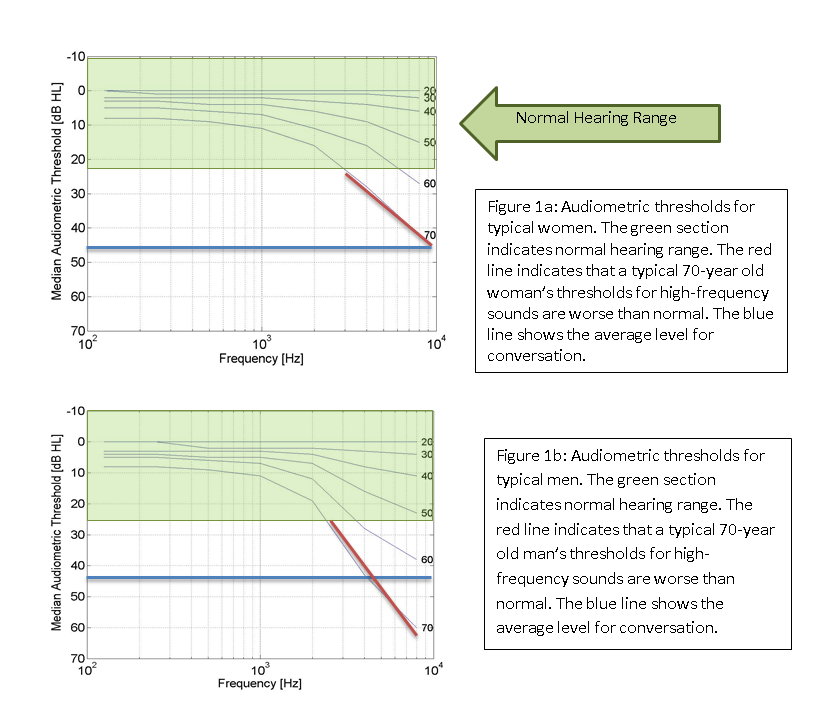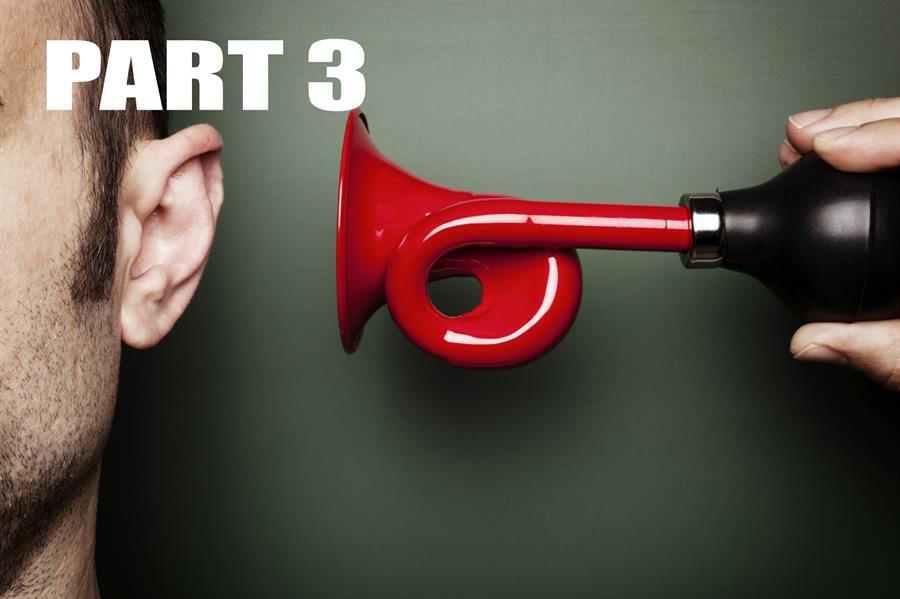Many of us begin to experience difficulties hearing as we age. It may seem like other people are mumbling or that it is easy to hear in some situations but almost impossible in other situations.
In Parts 1 and 2, we discussed aging-related hearing loss, and how the ear and the brain work together to listen in everyday life. In Part 3, we discuss what the results of a basic hearing test, an audiogram, can or cannot tell you about your hearing difficulties and why.
What does the audiogram tell you about your hearing?
The results of the most common hearing test are shown on an audiogram and these results are used to define ‘normal’ hearing.
The audiogram will tell you your hearing thresholds. A hearing threshold is the quietest sound (measured in decibels hearing level (dB HL)) at which you can hear a sound. The sound of a pin drop would be near the hearing threshold of a person with good hearing. During a basic hearing test, thresholds are measured for tones at different frequencies (measured in Hertz or cycles per second) that cover a range of five octaves. You can think of the frequencies of the tones used in the test as different notes played on a piano keyboard. Different frequencies have different pitches; like piano notes, some have a lower pitch (more bass) and some have a higher pitch (more treble). The results of the basic hearing test are plotted for each ear on a graph called an audiogram.
How good or bad is your audiogram? Is it typical for your age?
According to the International Organization for Standardization (ISO), Figure 1a and 1b shows the typical audiograms for women and men at different ages (1). Compared to these typical audiograms, half of the population would have better hearing thresholds; that is, their thresholds would fall above the line for a specific age and gender group. People who can hear very quiet sounds would have thresholds near the top of the audiogram. Similarly, half the population would have poorer hearing thresholds; that is, their results would fall below the line for a specific age and gender group. People who cannot hear sounds until the sounds are louder would have thresholds nearer to the bottom of the audiogram. If you have had a hearing test, you could compare your own audiogram to the ISO curve for you own age and gender group to see if your thresholds are better or worse.
How good or bad is your audiogram? Is it clinically normal?
As we age, hearing thresholds at the higher frequencies usually change more than thresholds at lower frequencies. That is, we usually do not hear high-frequency (treble) sounds as well as low-frequency (bass) sounds. This means that it takes more decibels to make high-frequency (treble) sounds loud enough for older people to hear them. Quiet, high-frequency sounds like a clock ticking or a bird chirping might become impossible to hear. Hearing loss at higher frequencies is common and some might consider this type of hearing loss to be ‘normal’ for older adults.
However, the definition of normal hearing used by the World Health Organization is not adjusted for age (2). Hearing is considered to be clinically normal if thresholds are between 0 and 25 dB HL. The green section (top of Figure 1a) shows the normal hearing range. If your threshold is in the green box then it is normal. If you are like many other older people then you might have normal thresholds at lower frequencies but not at higher frequencies. The red line on Figure 1a shows that a typical 70-year old woman would have high-frequency hearing thresholds that are worse than the clinically normal range (below the green box). This is the case, even though her hearing thresholds are typical for her age and gender. This means that you might have typical hearing for your age and gender, but your thresholds might not be as good as a younger person and they might not be considered to be clinically normal.
Thresholds on an audiogram can be interpreted as follows:
- normal is 0-25 dB HL
- greater than 25 dB HL indicates a hearing loss.
- between 26 and 40 dB HL indicates slight or mild hearing loss
- over 40 dB HL indicates moderate or greater hearing loss.
Figure 1: Audiograms of women in top panel and men in bottom panel (adapted from the International Organization of Standardization (1)).

Can the audiogram explain problems understanding conversation?
Conversation is a lot louder than a pin drop. The blue line on audiogram in Figure 1a and 1b shows that the average level of conversation is around 45 dB HL, This means that people who have normal hearing thresholds have no difficulty hearing conversation because it is plenty louder than their hearing thresholds. Speech sounds will be heard but only faintly by people with mild hearing loss. Speech sounds may not be heard at all by people with a moderate or greater hearing loss. Older people who have typical age-related hearing loss, with poorer thresholds in the higher frequencies, may hear some speech sounds well but not hear other speech sounds at all. The most difficult speech sounds to hear are consonants (e.g., p, f, t, k) because these speech sounds rely more on higher frequencies. Vowels are easier to hear because they rely more on lower frequencies. Older adults will often complain that “I hear people talking but the voices are not clear and it is hard to understand what they are saying”. Although people with hearing loss often blame other people for mumbling, a more likely explanation is that an older person with a typical high-frequency hearing loss can only hear some speech sounds and misses other speech sounds when people are talking.
Although the audiogram is a good test for measuring the quietest sounds you can hear, the hearing problems of older adults are often not fully explained by the audiogram. Even when sounds are loud enough, and even if older adults have normal audiograms, it is still common for them to complain about hearing problems, especially when they are trying to listen in busy, noisy, or group situations. To understand why people have trouble hearing even when sounds are loud enough, we have to know more about what goes wrong in the auditory (hearing) system as people age.
Does the audiogram detect all types of hearing loss?
Researchers have realized for a long time that aging can result in different types of hearing loss (3). Carefully controlled research on animals has provided evidence for three types of hearing loss that could worsen with age (4). Two types result in poorer thresholds for high-frequency sounds and could explain the changes in the audiogram discussed earlier.
Type 1: In the first type, the outer hair cells in the inner ear are damaged. This damage occurs usually by being exposed to environmental factors such as very high noise levels. Younger adults who work in industrial noise can also get this type of hearing loss.
Type 2: The second type involves changes in the blood supply to the inner ear that alter its chemistry. These chemical changes in the ear have been compared to a battery going flat (5). This type only occurs in older adults.
Type 3: The third type involves damage to the nerves connecting the ear to the brain. Evidence suggests that lifelong exposure to noise can cause neural damage to the auditory nerves. This nerve damage disrupts the way in which information from the ear is delivered to the brain (1). Such damage can occur even if the noise is not loud enough to permanently change hearing thresholds.
As people age, they often develop a combination of the three types of age-related hearing loss, but Type 3, neural damage, might not be detected by the audiogram. Speak to your doctor if your audiogram appears normal for your age but you are still having problems hearing in daily life.
Why doesn’t making sounds louder always helps?
Of course, one of the problems with high-frequency hearing loss is that some sounds simply cannot be heard. Making sounds louder (for example, by using a hearing aid) will help to bring sounds back into the audible range. In general, it is better to hear sounds than not to hear them. However, some people, especially those with the first type of age-related hearing loss described above (Type 1: damage to the outer hair cells in the inner ear), may actually become less able to tolerate loud sounds. This means that the hearing aid circuits need to make sounds loud enough but also protect the hearing aid wearer from sounds that are too loud. In addition, for most people with hearing loss, making sounds loud enough to hear does not necessarily make sounds clearer. The clarity of sound can be reduced because the ear can no longer analyze sounds properly.
It is common to have difficulties picking out one sound when many sounds are heard at the same time. For people who have the third type of age-related hearing loss described above (Type 3: neural damage), problems with reduced clarity and the feeling that sounds are jumbled together can happen even if the person’s audiogram is normal. Making sounds louder will not solve all listening problems, especially those resulting from neural damage. These problems are less about loudness and more about the how well the signals are sent from the ears to the brain. The good news is that, even if making sounds louder is not enough, other solutions might help solve the problems that many older listeners have in daily life (see Part 4).
In this four-part blog post series we cover various aspects of hearing loss:
- In part 1, we discuss how changes in hearing and cognition (for example, memory) affect communication and social interactions in healthy older adults;
- in part 2, how hearing impairment may be related to cognitive impairment and dementia;
- in part 3, what hearing tests can and cannot tell you about your hearing problems; and
- and in part 4, when you should get your hearing assessed and what solutions might help you if you or your friends or family are having problems.





